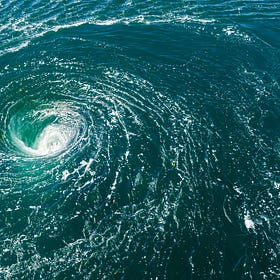New Research: Ocean Current Collapse More Likely, and Sooner, Than We Thought.
We have to cut carbon emissions NOW or face a point of no return and an inevitable collapse in 100 years, 50 years, or even sooner.
For those of you who are Newbies for us, here is out white paper on how the ocean currents work and what has happened before when they shut down. It’s in the public domain, so feel free to pass it around, use it in the classroom (if you’re not arrested for it!), and to keep as a reference.
Atlantic ocean currents are near collapse. That could bury Europe in glaciers.
EDITOR’S NOTE: A couple of years ago, I published this article for PolitiSage subscribers on the slowdown of AMOC—the Atlantic Meridional Overturning Circulation. This is the worldwide current and series of gyres that keep the world from turning into Snowball Earth. The collapse of the AMOC h…
Now, what’s news this week is that the newest run of the data shows that the collapse of the AMOC (the current around Antarctica that helps drive world ocean circulaiton) is both more likely than we thought—and will happen faster.
The good news is that it’s s till in our hands—but it won’t be for long. The bottom line is that humans must make “deep cuts to fossil fuel emissions” if we’re to dodge a collapse and avoid “catastrophic impact”.
What Happens if the Ocean Currents Stop Circulating?
Writes The Guardian on the current around Antarctica:
The Atlantic Meridional Overturning Circulation (Amoc) is a major part of the global climate system. It brings sun-warmed tropical water to Europe and the Arctic, where it cools and sinks to form a deep return current. The Amoc was already known to be at its weakest in 1,600 years as a result of the climate crisis.
Previously we thought this brewing crisis might take a couple of hundred years to develop, but new analysis show the tipping point that makes an Amoc shutd own inevitable is likely to be passed within a few decades, but that the collapse itself may not happen until 50 to 100 years later. And it could happen sooner.
The Guardian:
The research found that if carbon emissions continued to rise, 70% of the model runs led to collapse, while an intermediate level of emissions resulted in collapse in 37% of the models. Even in the case of low future emissions, an Amoc shutdown happened in 25% of the models.
What Happens If Ocean Currents Shut Down or Significantly Slow Down?
Here’s the short list. The longer one touches every place on earth. A shutdown/slow down would:
Shift the tropical rainfall belt on which many millions of people rely to grow their food …
Plunge western Europe into extreme cold winters and summer droughts
Add 50cm—19.685 vertical inches—to already rising sea levels.
Professor Stefan Rahmstorf of the Potsdam Institute for Climate Impact Research terms the new results “quite shocking.”
There’s a saying that geological time is 200,000 years of sheer boredom followed by a year of sheer terror. And what we’re looking at here is, potentially, a 1,500-year ice age in the Northern Hemisphere, similar to the Younger Dryas Period, which would devastate Western Europe for more than a millennium.
Professor Rahmstorf continues: “These numbers are not very certain, but we are talking about a matter of risk assessment where even a 10% chance of an Amoc collapse would be far too high.” He continues:
“We found that the tipping point where the shutdown becomes inevitable is probably in the next 10 to 20 years or so. That is quite a shocking finding as well and why we have to act really fast in cutting down emissions.”
Dr. Rahmstorf’s assessment is back up by one from Professor Sybren Drijfhout, at the Royal Netherlands Meteorological Institute, who was also part of the team.
“Even in some intermediate and low-emission scenarios, the Amoc slows drastically by 2100 and completely shuts off thereafter. That shows the shutdown risk is more serious than many people realise.”
As to the bottom line, the Guardian writes that
… air temperatures are rising rapidly in the Arctic because of the climate crisis, meaning the ocean cools more slowly there. Warmer water is less dense and therefore sinks into the depths more slowly. This slowing allows more rainfall to accumulate in the salty surface waters, also making it less dense, and further slowing the sinking, forming the feedback loop. Another new study, using a different approach, also found the tipping point is probably going to be reached around the middle of this century.
Rahmstorf said the true figures could be even worse, because the models did not include the torrent of meltwater from the Greenland ice cap that is also freshening the ocean waters.
We are in a bad position with greenhouse gases already, and authoritarian regimes, ours among them, are shutting down climate programs, satellite imagery gathered for analysis, and outlawing even the discussion of climate change. We’ll keep talking about it.
We will start experiencing these changes in our own lifetimes unless we are now very, very old. Our children, and our grandchildren, will live a world very different than the one we have known. How bad that gets for them will depend upon what we do now.
Stay safe out there …




This is such a critically important article that I am glad you are repeating it. This information is virtually (if not almost completely) unknown. I would very much like to see you repost it every month. I restacked it. Do you have other forums in which to publish it?